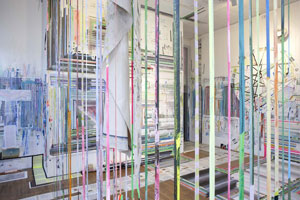
May 27, 2010
Miniskirt, Bodysuit, Orff Spice MoMA PS1 Extravaganza

Like a Pied Piper luring innocents to an unwelcome fate, “Greater New York” sounds too good to be true.
The triumphant blare of “Carmina Burana” infiltrates every part of this exhibition of very new art, which is spread throughout the former Long Island City high school housing the Museum of Modern Art’s contemporary-art affiliate, now called MoMA P.S.1.
Curators from the Museum of Modern Art and P.S.1 stage the extravaganza every five years.
Carl Orff’s heart-thumping cantata is actually the soundtrack for “the conductor (fortuna imperatrix mundi),” a compulsively watchable video by 30-year-old Rashaad Newsome, a standout of the 2010 Whitney Biennial.
Using furious, jump-cut editing, the piece contrasts celebratory hip-hop culture with its rappers’ self-aggrandizing misogyny.
It also provides the 68-artist exhibition surrounding it with a pulse it otherwise lacks.
First drawing visitors past an impressive simulation of a dying rainforest by David Brooks, Orff’s music propels them through Lucy Raven’s grating, stop-motion video illustrating the global waste of energy involved in transforming copper ore mined in Nevada into conducting wire refined in China.
At least there’s humor in Deville Cohen’s ultra-clever video of an underground carwash, in which four high-heeled, miniskirted women prep a large gray print of a car for marriage with a truck, using shredded-paper brushes and everyday kitchen objects.
Nice Phonies
The scene, which cleverly fuses the real with the surreal, was shot at P.S.1, where Cohen is one of several artists in the show whose work has emerged from residencies there.
Another is Franklin Evans, who has altered the architecture of his room by using colorful cut-paper strips as dividing struts and curtains, and squirted the walls with skeins of paint.
Hank Willis Thomas adds double-edged captions to 82 color photographs depicting popular African-Americans as attractive flunkies promoting a phony racial equality in movies, sitcoms or advertisements for hair-straightening and skin-bleaching products. Spanning four decades of cultural assimilation, the series is the punchiest work in the show.
Others to watch:
I liked the gawkiness of Debo Eilers’s hot-pink constructions, and Tala Madani’s animations of drawings whose initial serenity is undone by random violence.
Photographs by LaToya Ruby Frazier (black-and-white urban landscapes), Erin Shirreff (neoclassical images of single animal teeth) and Pinar Yolacan (color portraits of corpulent women encased head-to-toe in rubber, print and denim bodysuits) were all compelling, even if they weren’t very original.
The show isn’t a static enterprise, however. The best may be yet to come.
Many artworks will evolve or decay during the exhibition, which includes a show-within-a-show by a rotating quartet of guest curators known for their discoveries.
There’s also an almost-daily program of both films and live performances, like the dance lessons the nimble Ryan McNamara is taking at a ballet barre in the lobby until Oct. 16, when he will perform throughout the building.